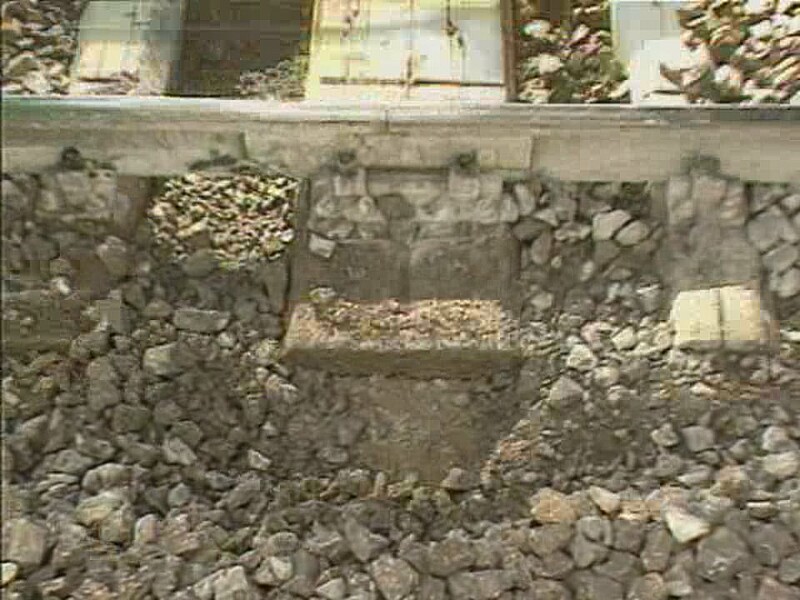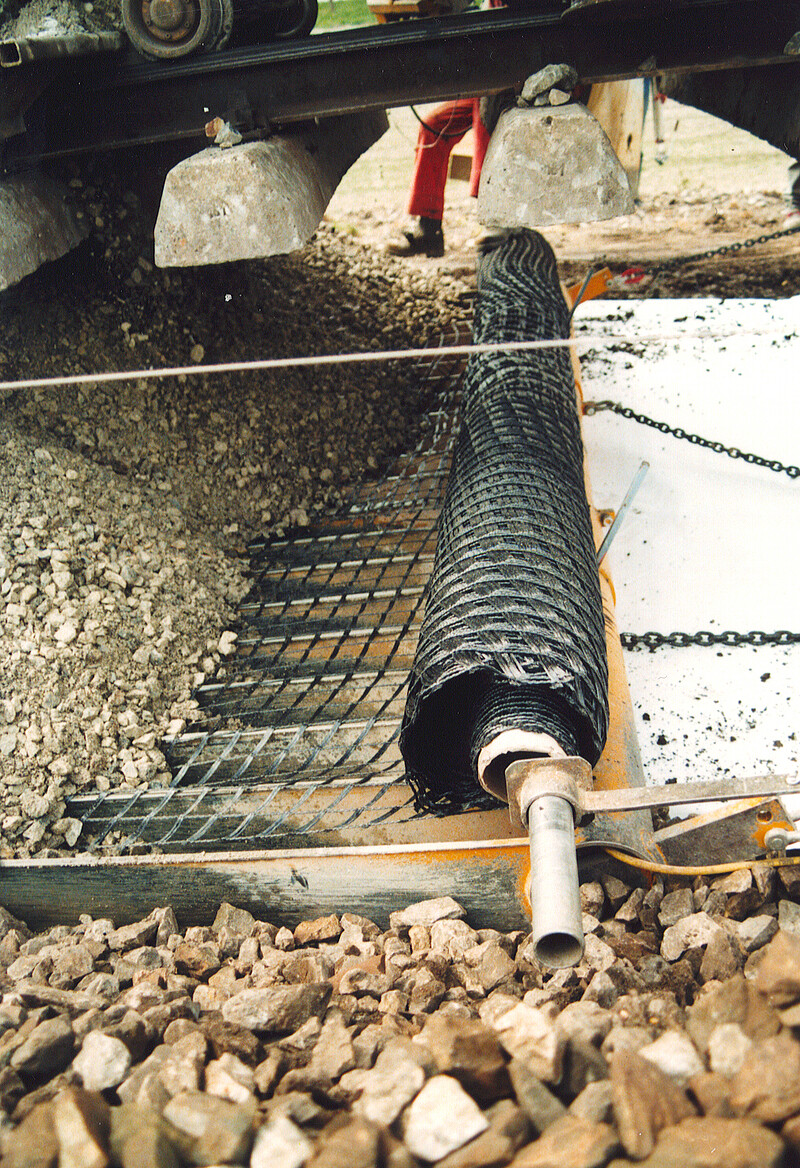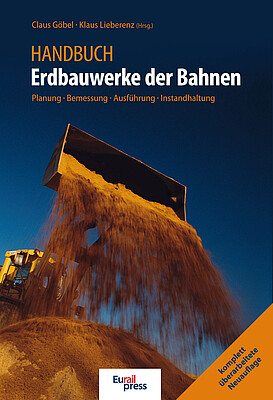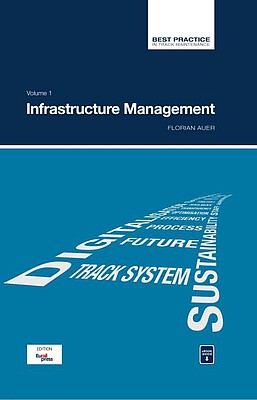Geosynthetics
Soils have limited load carrying capacity, which depends on their composition and water content. If this is exceeded by the transmitted loads the soil can no longer withstand the stress and gives way under plastic deformation. There are various ways in which the load carrying capacity of the soil can be improved. Originally reeds, straw and brushwood were used to improve soil properties, but today sand-gravel mixtures are preferred. Where their properties are not sufficient to give a satisfactory result, further action is needed. These range from profound building activities (e.g. bored piles, milling mixing-injection procedures, etc.) through hardening with binders which is used in road building to the use of geosynthetics as part of sand-gravel mixtures.
Far-reaching measures to improve the existing routes are only occasionally used in railways for special applications, because they often take a lot of time. The deliberate use of geosynthetics in sand-gravel mixtures improves their positive effect and allows the production with far more efficient construction methods. Originally, geosynthetics were used as pure non-woven fabrics. Their current tasks are versatile and include the following[1]:
- separation
- filtering
- draining
- protection
- reinforcement
- sealing
Separation, filtering, draining[2]
The filtering and separation task of the geotextile prevents mixing between the subgrade and the ballast. If there is exposed cohesive soil a passing train will trigger a pumping process, allowing fine particles to penetrate into the ballast bed. The use of geotextiles stops this effect, however, it does not seal the subgrade, but enables water to flow away. Water can seep away as usual or run into the side ditch.

Reinforcement
Like the use of steel in reinforced concrete components, consideration was given to the use of geosynthetics to improve the load bearing capacity. Fabrics and geogrids can accept for this purpose large tensile forces under high shape stability. The low change of shape and the large contact surface to the surrounding material are necessary in order to distribute the traffic loads better on the surrounding soil. Geogrids fulfil these tasks very well due to their specific structure. A combination of these properties enables composites to be used. These are made from geotextile components and geogrids and thus combine the properties of both groups.[2]
Multi-layered "reinforced" track bed layer systems can be installed on-track and improve the load bearing capacity significantly. The operating limitations and the costs can be significantly reduced in comparison to far-reaching measures. This possibility is, therefore, a worthwhile alternative, especially on main lines.[3]
In some secondary lines, geotextiles are used directly in the ballast in order to increase the load carrying capacity of the system, but this makes the future upgrading more difficult. Such restrictions should, therefore, already be taken into account during installation.
Sealing
Especially in water protection areas the adjacent soil must be protected from possible seepage of contaminated surface water. The water is collected and fed to the appropriate recipient by the shortest path. In order to prevent seepage, the subgrade is covered with a layer that is impermeable to water over the desired area.
Mineral seals, plastic membranes and geosynthetic clay sealing lines can be used for this purpose. During installation, attention should be given to the different special requirements. Mineral seals from cohesive soils are not recommended because of their sensitivity to frost and low deformation resistance.[2]
Protection
Geosynthetics with protection tasks keep sensitive components (e.g. sealing membranes) against mechanical damage. This particularly applies to shear and pressure stress caused by the bordering soil. Geosynthetics with a protective function must have sufficient thickness and a high resistance to perforation.
In addition to the traditional use of geosynthetics in the direct area of the track, these are also used in conventional earth and support structures as well as side path constructions.[4]
You can find suitable specialist literature to the topic here:
Railway Transformation
The second edition of Railway Ground Engineering has been completely reworked and extended. It provides comprehensive information on the essential relationships and dependencies between superstructure, substructure and subsoil subjected to the effects of the rail System.
This manual is intended to be a practical reference book for everyone involved in the planning, design and construction of earthworks and other geotechnical structures, as well as a manual for low track maintenance . With the comprehensive presentation of the new partial safety concept in geotechnics, it is also a valuable aid for students and teachers at universities and technical Colleges.
Best Practice in Track Maintenance, Vol 1 - Infrastructure Management
Infrastructure Management Volume 1 looks at aspects of infrastructure management with particular reference to the single European railway area. Based on best-practice examples from Central Europe, measures for the targeted retrofitting and improvement of the infrastructure maintenance of the existing network are presented. In many cases, infrastructure operators are faced with a generational change, which accelerates the process. Modern information and communication technology can simplify the comprehension and presentation of complex contexts. Modified approaches to asset management and life-cycle management enable implementation of the "transparent permanent way" or the "railway 4.0".
- [1] Lieberenz, K.; Piereder, F.: Entwicklung von Schutzschichten mit Geokunststoffen. Eisenbahningenieur Kalender 2013, S. 252–270.
- [2] Fischer, R.; Göbel, C.; Lieberenz, K. et al.: Handbuch Erdbauwerke der Bahnen. Planung, Bemessung, Ausführung, Instandhaltung. Eurailpress in DVV Media Group, Hamburg, 2013.
- [3] Wegener, D.; Fischer, R.: Dynamische Stabilität bei Bahnstrecken auf Weichschichten. Der Eisenbahningenieur 2016 (2016), Sonderheft Geotechnik, S. 27–32.
- [4] Hempel, M.; Hangen, H.: Einsatz von Geokunststoffen im Eisenbahnbau. Der Eisenbahningenieur 2016 (2016), Sonderheft Geotechnik, S. 4–6.




